Rebecca’s Recipe of the Week: A Restorative Soup
This is what you need if you have eaten a lot of rich food over the holidays. The lentil soup is soothing, but not at all boring, enlivened as it is with marinated artichoke hearts and a swirl of yoghurt. You will feel better after eating this, I promise. Note, too, that it uses some of those leeks, carrots and celery that have accumulated in your fridge from the double share.
Lentil Soup with Artichoke
Serves 4
Ingredients
2 tablespoons olive oil
2 leeks, trimmed, halved lengthwise and sliced thin
3 medium carrots, peeled, halved lengthwise and sliced thin
4 celery sticks, sliced thin
1 heaped tablespoon grated fresh ginger
1 Canalside chile, left whole
4 cloves of garlic, peeled and chopped fine
250g green lentils
2 tablespoons cider vinegar
1.5l stock or water
1 teaspoon salt
5 heaped tablespoons coarsely chopped parsley
120g artichoke hearts from a jar, drained and sliced thin, to serve
plain or Greek yoghurt, to serve (if desired)
Preparation
Heat the oil over medium heat in a large saucepan with a lid. When it is warm add the leeks, carrots, celery, ginger and chile. Fry for about 10 minutes, or until the vegetables have softened and are starting to colour.
Add the garlic and stir for a few minutes more.
Stir in the lentils, and add the vinegar and water. Bring to a boil and simmer until the lentils are tender—20-30 minutes, probably. Add some more water if they seem dry.
Purée about a third of the soup in a liquidiser or food processor, and then stir this back into the pan. Add the salt and stir in most of the parsley, keeping back a little for a garnish.
Dish into bowls and place a sliced artichoke heart in the centre of each bowl. Sprinkle the remaining parsley over the top. Serve with a spoonful of yoghurt on top, if desired.
Recipe adapted from Annie Bell, Plant Power: Protein-rich Recipes for Vegetarians and Vegans (2020).
Rob’s Recipe of the Week: Caramelised Cabbage
This recipe isn’t so Christmassy, but I did enjoy it. I found the liquid took a lot longer than stated to reduce, but in the end I would actually have preferred a bit more sauce when serving. Goes well with mash!
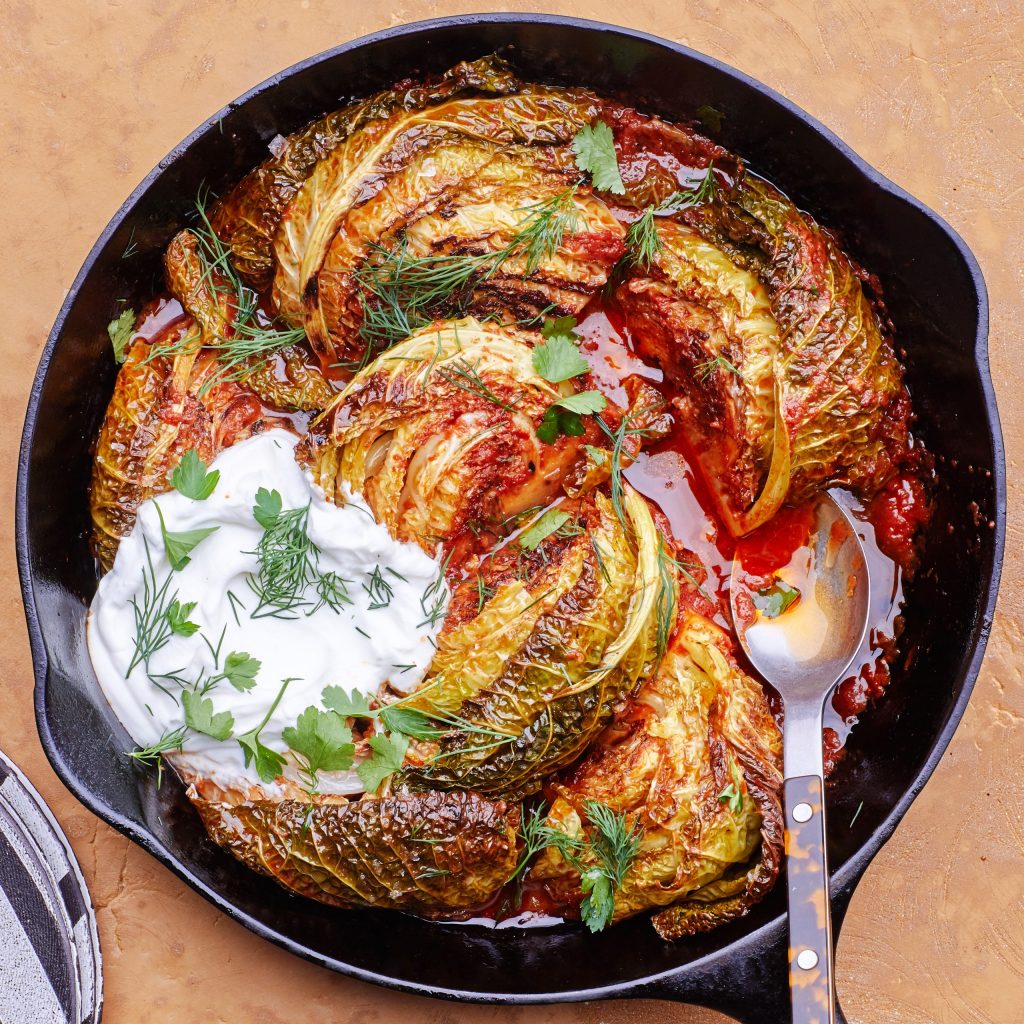
Ingredients
¼ cup double-concentrated tomato paste
3 garlic cloves, finely grated
1½ tsp. ground coriander
1½ tsp. ground cumin
1 tsp. crushed red pepper flakes
1 medium head of green cabbage
½ cup extra-virgin olive oil, divided
Salt
3 Tbsp. chopped dill, parsley, or coriander
Full-fat Greek yogurt or sour cream (for serving)
Method:
Preheat oven to 180°. Mix tomato paste, garlic, coriander, cumin, and red pepper flakes in a small bowl.
Cut cabbage in half through the core. Cut each half through the core into 4 wedges.
Heat ¼ cup oil in a large oven safe frying pan (or similar) over medium-high. Working in batches if needed, add cabbage to the pan cut side down and season with salt. Cook, turning occasionally, until lightly charred, about 4 minutes per side. Transfer cabbage to a plate.
Pour remaining ¼ cup oil into pan. Add spiced tomato paste and cook over medium heat, stirring frequently, until tomato paste begins to split and slightly darken, 2–3 minutes. Pour in enough water to come halfway up sides of pan (about 1½ cups), season with salt, and bring to a simmer. Nestle cabbage wedges back into skillet (they should have shrunk while browning; a bit of overlap is okay).
Transfer cabbage to oven and bake, uncovered and turning wedges halfway through, until very tender, liquid is mostly evaporated, and cabbage is caramelized around the edges, 40–50 minutes.
Scatter dill/other over cabbage. Serve with yogurt alongside.
From BonAppetit.com
Rebecca’s Recipe of the Week: Pumpkin, Barley, Fennel, Cheese
This is a very attractive dish—so attractive, in fact, that you could consider it for a vegetarian Christmas. In any event, it’s extremely tasty. The cheese and roasted fennel blend with the soft, chewy barley to make an indulgent filling for the baked squash. Crunchy toasted oat flakes provide a pleasing contrast on the top.
It is an excellent use of the charming small squashes we’re getting in our shares these days.
To serve, stand these proudly on a platter, topped with their little squash-top berets.
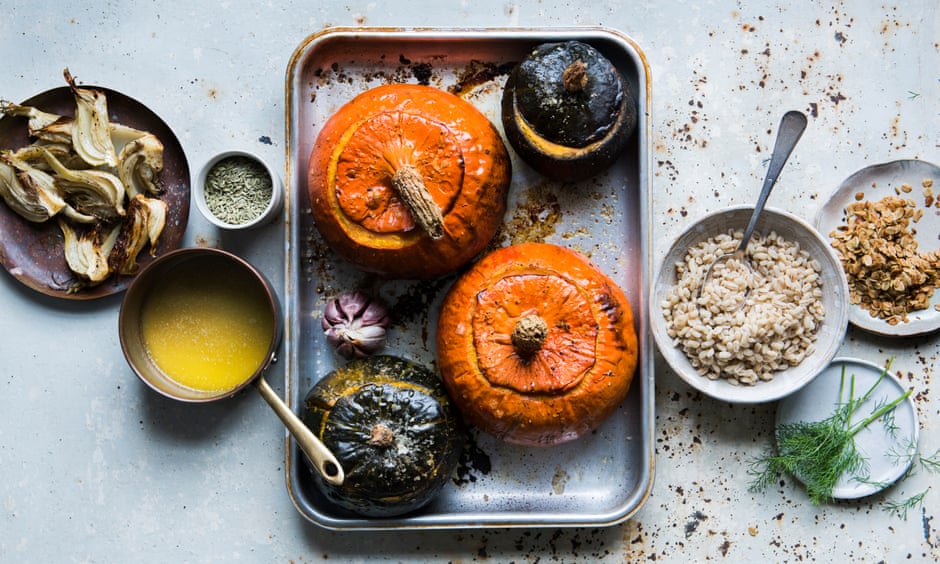
Whole roast squash
Serves 4
Ingredients
A mixture of whole squashes: about 750g squash per person
4 fennel bulbs—keep the lacy fronds at the top
1 garlic bulb (leave it whole)
Olive oil
Salt and black pepper
250g pearl barley
125g sharp cheddar or other cheese
1 lemon, zested
1 red chilli, deseeded if you like
A knob of butter
50g rolled oats
1 tsp fennel seeds
Preparation
Preheat the oven to 180C. Use a big, heavy knife to cut off the base of each squash, so they sit upright on a tray. Cleanly cut the top off each one in a single piece (you are going to put the tops back on) about 3-4cm from the top. Use a metal spoon to scoop out the seeds and the fibres until you have a neat hollow.
Trim the fennel, removing any tough outer leaves, then cut the bulb into a few big wedges. Keep those fronds!
Put the squash in a large roasting tray or two. Scatter the fennel wedges around and put the bulb of garlic on too. Drizzle the lot with olive oil, making sure you get inside the squash, and season with salt and pepper. Put the tops back on the squash. Roast for 45-60 minutes, or until the squash are tender and the fennel has started to soften and brown. If your squash take a little longer, you can remove the fennel once it’s nicely soft and brown around the edges, as you don’t want it to overcook.
Meanwhile, put the pearl barley in a medium pan and cover with cold water. Add a big pinch of salt, then bring to the boil and simmer until al dente (about 25-30 minutes). Drain and transfer to a large bowl.
Remove the garlic and fennel from the roasting dish. When cool enough to handle, squeeze the roasted garlic out of its papery skins, into the barley. Roughly chop the fennel and add it to the bowl along with the cheese, lemon zest, salt and pepper. Chop the fennel fronds to make about a quarter cup. Chop the chilli and add both. Taste the mixture and adjust the seasoning.
Divide the mixture between the squash and return them to the oven for 10 more minutes. Meanwhile, heat some butter in a small pan. Toss in the oats, fennel seeds, and a little salt and pepper. Stir for about 5 minutes, until the flakes are golden. Drain on a plate lined with kitchen paper.
Once the squash are out of the oven, sprinkle over the toasted oats and serve.
Recipe adapted from Anna Jones, The Guardian, 24 Oct. 2016
Rebecca’s Recipe of the Week: Pumpkin with Noodles
Here is a simple salad with pumpkin and soba noodles. Thomasina Miers recommends this as a weekday lunch, and observes that it is equally good warm or cold. She also points out that the dressing is tasty on grilled chicken or fish, or sprouting broccoli.
Miso-roast Pumpkin with Noodles
Serves 4
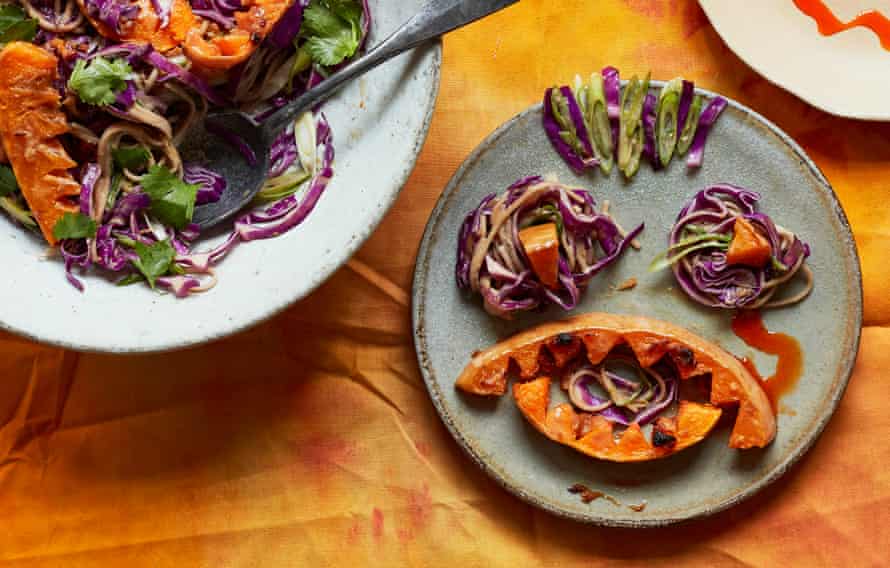
Ingredients
750g pumpkin
3 tablespoons white miso
2 tablespoons olive oil
125g soba noodles
500g red cabbage, shredded
1 large handful coriander, coarsely chopped
2 spring onions, finely sliced
Chile oil, to serve
For the dressing
2 tablespoons sesame oil
2 tablespoons light soya sauce
2 tablespoons lime juice
2 tablespoons tahini or other sesame paste
1 tablespoons honey
1 clove garlic, peeled and grated
1 inch ginger root, peeled and grated
A splash of water
Preparation
Heat the oven to 220C. Wash the pumpkin (peel if you prefer) and cut into wedges. Whisk the miso and olive oil and toss onto the pumpkin. Tip onto a baking sheet and roast for 30-35 minutes, or until tender and golden at the edges. Leave to cool.
Meanwhile bring a pan of water to the boil and cook the noodles according to the instructions on the packet, until al dente. Drain and rinse in cold water.
Mix the noodles, cabbage, most of the coriander, and spring onions in a bowl.
Make the dressing: whisk all the ingredients together.
Tip the dressing onto the ingredients in the bowl and blend.
Array the dressed vegetables on a serving platter and top with the roasted squash. Decorate with the remaining coriander and serve with chile oil on the side, for those who want this a bit spicy.
Recipe adapted from Thomasina Miers, Guardian, 31 Oct. 2020.
Rob’s Recipe of the Week: Chard Tzatziki
Chard is a common green throughout the winter, but with this recipe I hope to bring back a taste of the summer. I haven’t tried it yet but I’m expecting it to make a good tasty lunch!
Tzatziki yogurt dip
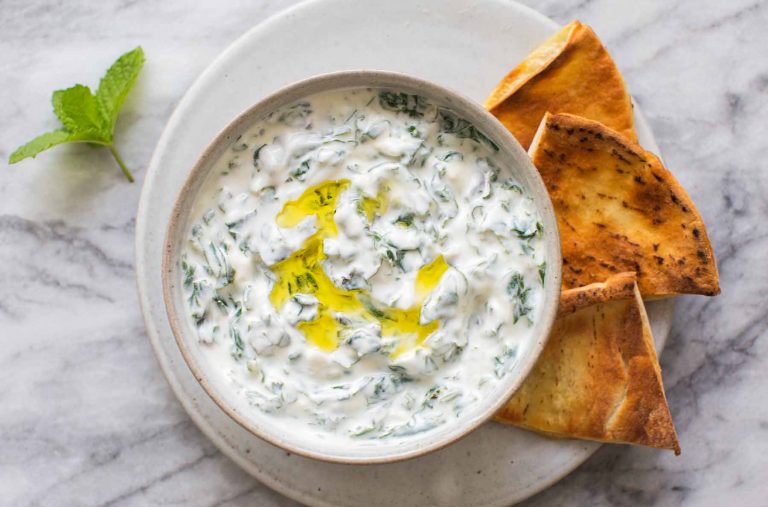
Ingredients:
3 to 4 large leaves of Swiss chard, ribs removed
1 cup plain Greek yogurt
1 1/2 Tbsp chopped fresh mint leaves
1 garlic clove, finely chopped
1/4 teaspoon salt
1 Tbsp extra virgin olive oil
1 teaspoon lemon zest
1 Tbsp lemon juice
Pita chips:
3 (9-inch diameter) pita breads, cut like a pie into triangles
Olive oil for drizzling on to the pita bread
Method
1 Blanch and chop the chard: Bring a 1 or 2 quart saucepan, half filled with water, to a boil. Add the chard leaves. Cook until tender, about 3 minutes.
While the chard is cooking, prepare a bowl with ice water for an ice bath. When the chard is cooked, remove it with a slotted spoon and put into the ice bath to stop the cooking.
When the chard has cooled, remove it from the ice water and bunch it into a ball. Wrap it in a paper towel and squeeze hard to remove excess moisture.
Chop up the chard.
2 Combine tzatziki ingredients: Put the Greek yogurt, chopped chard, chopped mint, garlic, salt, olive oil, lemon zest and lemon juice in a medium bowl. Stir to combine. Chill until ready to use (can make up to 3 days ahead).
3 Toast the pita bread: Cut the pita bread into triangles and layout in one layer in a grill pan (use a sturdy sheet pan or grill pan, not a thin baking sheet or your baking sheet will warp).
Drizzle olive oil on one side of the pita wedges. Use a pastry brush to spread the olive oil more evenly.
Place under the grill. Grill for 5 minutes or until the pita bread starts to toast. Remove and let cool for a minute.
4 Serve: Drizzle the tzatziki with a little olive oil and serve with toasted pita wedges.
Adapted from: https://www.simplyrecipes.com/recipes/swiss_chard_tzatziki_yogurt_dip/
Rebecca’s Recipe of the Week: Pumpkins, Lentils, Ginger
The zingy, fried ginger topping gives this dal an invigorating freshness. Absolutely don’t leave it out!
The ratio between the pumpkin and the carrots does not need to be precise and overall I used a good deal more pumpkin than the 200g called for in the original recipe. Plus I didn’t have a Kashmiri red chilli so I used a dried Canalside chile and that worked just fine. Serve with flatbreads or rice.
Red lentil dal with carrots, pumpkin, and fried ginger
Serves 4
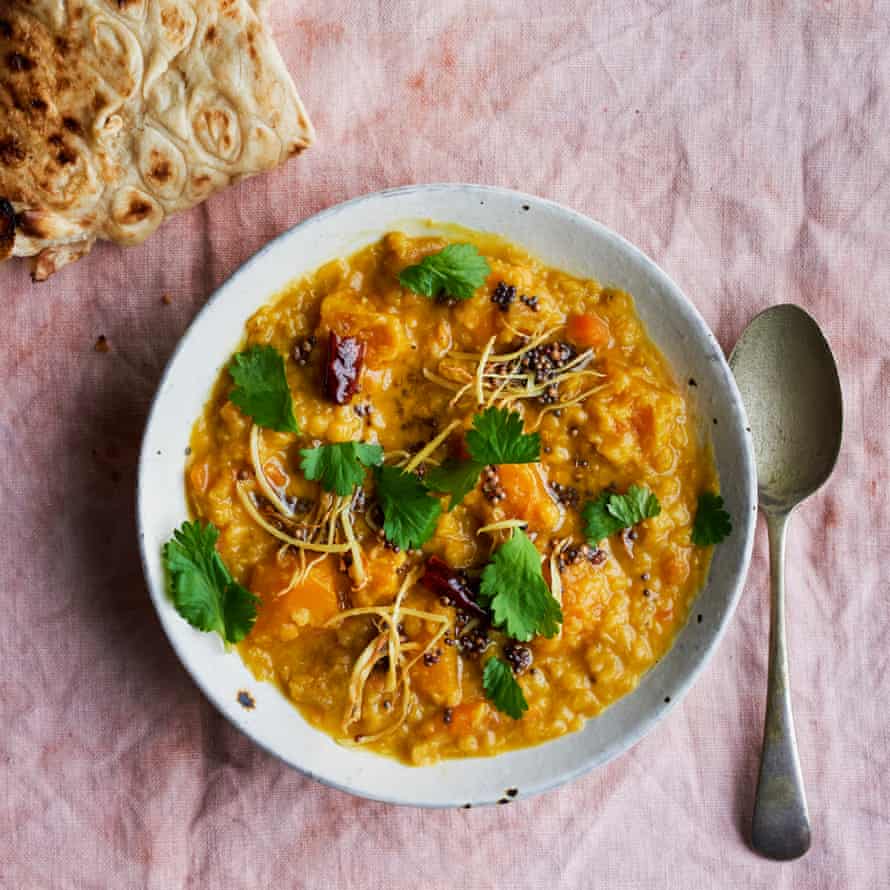
Ingredients
210g red lentils
3 tbsp coconut oil
150g onion, cut into half moons
100g carrots, finely diced
200-300g pumpkin, peeled and diced into 2cm pieces
½ tsp ground turmeric
½ teaspoon ground red chilli powder
1 teaspoon salt
2 tablespoon fresh lime or lemon juice
2 teaspoon coriander seeds, crushed
2 teaspoon black or brown mustard seeds
5cm piece fresh ginger, peeled and cut into matchsticks
1 Kashmiri red chilli
10g chopped fresh coriander leaves
Preparation
Clean the lentils for any debris, rinse under cold running water, then put in a bowl, cover with 500ml cold water and set aside.
Heat a tablespoon of the oil over medium-high heat in a medium saucepan. Add the onions, and saute until they turn translucent – three to four minutes. Add the carrots and pumpkin, and saute until tender – about eight minutes. Stir in the turmeric and red chilli powder, and cook for a further minute.
Add the lentils and their soaking water to the vegetables, stir in a teaspoon of salt and bring to a rolling boil over a medium-high heat. Reduce the heat to low, cover and leave to simmer until the vegetables are completely tender and cooked – about 20 minutes. Remove from the heat, stir in the lime juice, taste and season with salt as needed.
Heat the remaining coconut oil in a small saucepan over a medium heat. When the oil is hot, add the coriander and mustard seeds, and cook until the seeds start to pop. Add the ginger to the hot oil, cover the pan with a lid and swirl for 30 seconds, until the mustard seeds stop sputtering.
Break the Kashmiri chilli in half and toss it into the hot oil. Remove from the heat and swirl the contents of the saucepan for another 30 seconds, until the chilli turns crisp. Pour this hot mixture over the lentils. Garnish with the fresh coriander leaves and serve warm with buttered flatbread or plain rice.
Recipe adapted from Nik Sharma, Guardian 31 Oct. 2020.
Rob’s Recipe of the Week: Mini stuffed squash
I can’t remember the name of the mini squashes we got this week, but I felt they were too special just to cube and roast like normal, so here I’ve found a fun stuffed squash recipe which although aimed at a different variety, I hope will translate across. Enjoy!
INGREDIENTS
3 sweet dumpling squashes
1 tablespoon olive oil
1 small onion, diced (about 1/2 cup)
1/4 cup shelled pistachios, coarsely chopped
8 dates, coarsely chopped (about 1/4 cup)
1 teaspoon lemon zest
1 teaspoon cinnamon
1 cup cooked quinoa
Salt and freshly ground black pepper
INSTRUCTIONS
Preheat oven to 190C.
Cut squash in half and scoop out seeds. (The seeds can be roasted like pumpkin seeds.)
Place squash face-down in an oiled baking dish. Bake until tender when pierced with a knife, about 30 minutes. Remove squash from oven but keep oven on.
Prepare the stuffing while the squash is baking. Heat oil in a medium saucepan over medium heat. Add onions and sauté until onion is translucent. Add pistachios, dates, lemon zest, and cinnamon and sauté for another minute. Stir in the cooked quinoa and season to taste with salt and pepper.
Turn the squash upright in the baking dish and stuff with the quinoa mixture.
Cover dish and bake for another 20 minutes.
Serve warm, garnished with extra pistachios or lemon zest, if desired. The peel of sweet dumpling squash is generally tender enough to be eaten.
From https://www.thekitchn.com/recipe-quinoa-stuffed-sweet-du-72643
Rob’s Recipe of the Week: October, American style
This year I thought I would do something different with my Canalside pumpkin, so I’ve been looking up pumpkin pie recipes. This may suit small shares better, as some reading has suggested smaller pumpkins are better suited to pie, but I’ll be trying anyway with my massive medium share pumpkin and probably making soup out of the remainder.
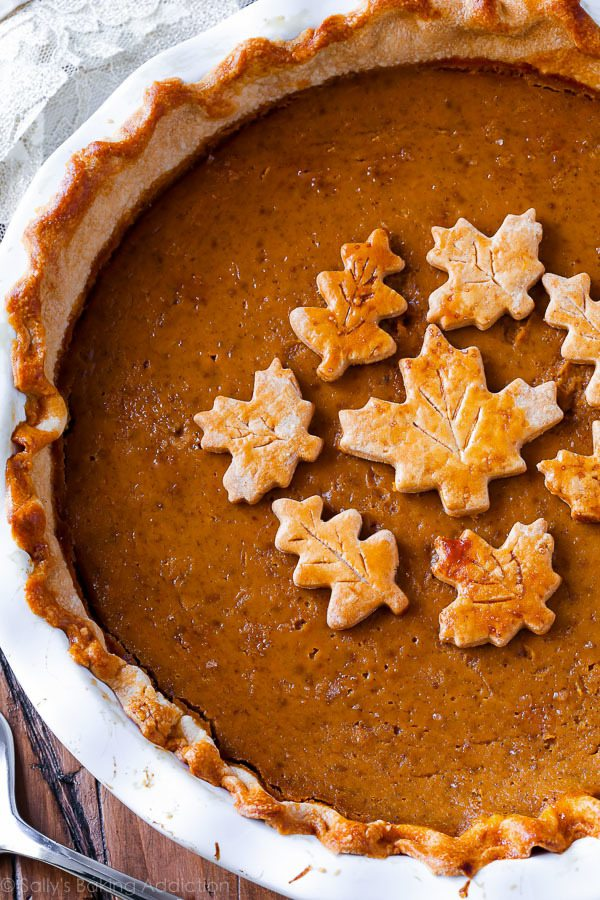
Pumpkin puree (pie recipe to follow below, use the remainder of this for soup)
4-6lbs (1.8-2.8kg) pumpkin makes 5-6 cups puree, 2 cups needed for pie
Preheat oven to 200degC then rinse and pat dry the pumpkin. Cut from stem to end, but don’t try to cut through the stem (it’s too tough). When you’ve cut through the pumpkin, just pull each half apart. Do this in two parts. Cut one side from the stem down to the bottom of the pumpkin. Remove the knife, rotate the pumpkin to the opposite side then do the same. When there is a slit down both halves of the pumpkin, put down the knife and pull the halves apart. They should separate at the stem.
Scoop out the seeds and most of the stringy bits. Lightly season the inside of the pumpkin halves with salt then place cut-side-down onto the baking sheet. Bake until the pumpkin can easily be pierced with a knife in several places and the flesh is pulling away from the skin, 45 to 60 minutes.
Cool until you can safely handle the halves then scoop out the soft flesh into a food processor. Process until very smooth, 3 to 5 minutes.
Pumpkin Pie
Ingredients:
Sweet shortcrust pastry (350g approx), chilled
About 2 cups; 450g pumpkin puree
3 large eggs
1 and 1/4 cups (250g) packed light or dark brown sugar
1 Tablespoon (8g) cornstarch
1/2 teaspoon salt
1 and 1/2 teaspoons ground cinnamon
1/2 teaspoon ground ginger
1/4 teaspoon ground or freshly grated nutmeg
1/8 teaspoon ground cloves
1/8 teaspoon fresh ground black pepper
1 cup (240ml) double cream
1/4 cup (60ml) milk
egg wash: 1 large egg beaten with 1 Tablespoon milk
Method:
For the pumpkin pie filling: Whisk the pumpkin, 3 eggs, and brown sugar together until combined. Add the cornstarch, salt, cinnamon, ginger, nutmeg, cloves, pepper, cream, and milk. Vigorously whisk until everything is combined. Filling will be a little thick.
Preheat oven to 190°C
Roll out the chilled pie crust: Remove 1 disc of pie dough from the refrigerator. On a lightly floured work surface, roll the dough out into a 12-inch circle. Make sure to turn the dough about a quarter turn after every few rolls. Carefully place the dough into a 9-inch pie dish. Tuck it in with your fingers, making sure it is smooth. With a small and sharp knife, trim the extra overhang of crust and discard. Crimp the edges with a fork or flute the edges with your fingers, if desired. Brush edges lightly with egg wash mixture. Line the pie crust with parchment paper. (Crunch up the parchment paper first so that you can easily shape it into the crust.) Fill with pie weights. Make sure the weights are evenly distributed around the pie dish. Pre-bake the crust for 10 minutes. Carefully remove the parchment paper/pie weights.
Pour pumpkin pie filling into the warm pre-baked crust. Only fill the crust about 3/4 of the way up. (Use extra to make mini pies with leftover pie dough scraps if you’d like.) Bake the pie until the center is almost set, about 55-60 minutes give or take. A small part of the center will be wobbly – that’s ok. After 25 minutes of baking, be sure to cover the edges of the crust with aluminum foil or use a pie crust shield to prevent the edges from getting too brown. Check for doneness at minute 50, and then 55, and then 60, etc.
Once done, transfer the pie to a wire rack and allow to cool completely for at least 3 hours.
Adapted from: https://www.inspiredtaste.net/35527/easy-pumpkin-puree-recipe/ and https://sallysbakingaddiction.com/the-great-pumpkin-pie-recipe/
Rebecca’s Recipe of the Week: Pasta with Creamy Carrot Miso Sauce
Another very good recipe from Slyvia Fontaine. The creamy carrot sauce colours the pasta a beautiful gold, while the fresh, herby gremolata adds vibrant green. Toasted breadcrumbs provide a contrasting crunch against the richness of the sauce. You would certainly not guess that this is vegan, but you’ll see right away how beautiful it looks in your bowl. The flavours work really well together and I recommend this highly.
Pasta with Creamy Carrot Miso Sauce
Serves 4
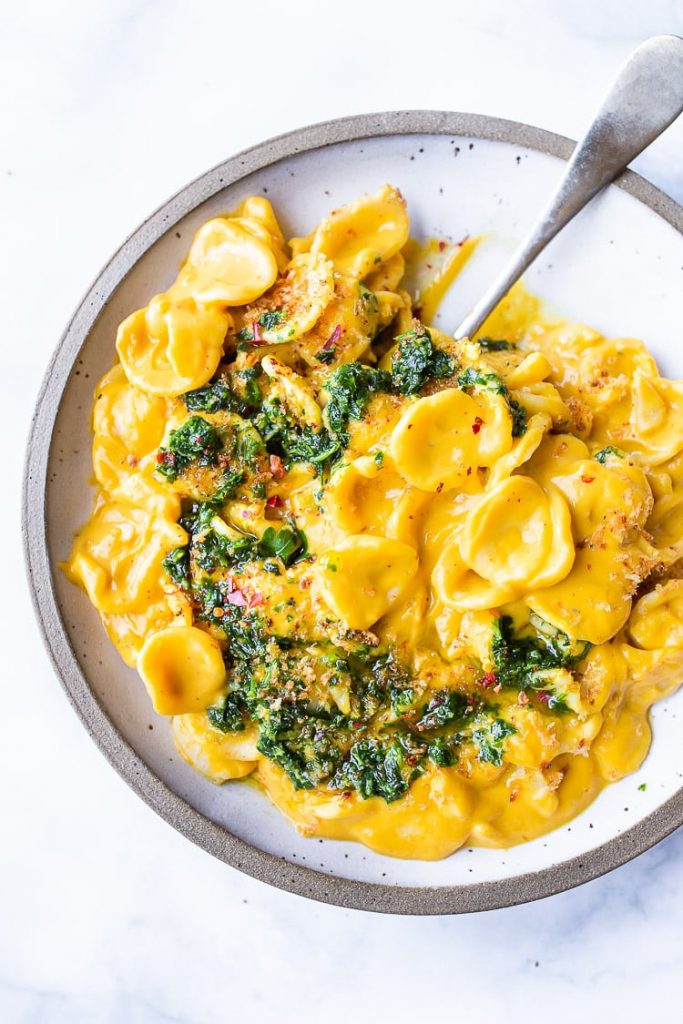
Ingredients
Carrot Miso Sauce
2 shallots, rough chopped (or 1/2 an onion)
3 large garlic cloves, rough chopped
2 tablespoons olive oil
150g carrots
450ml water
40g cashews
Freshly-ground pepper
3 tablespoons white miso paste
Gremolata
60g fresh coriander or parsley (Sylvia notes you can also use carrot tops)
1 tablespoon lemon zest ( zest from one medium lemon)
¼ teaspoon salt
1 fat garlic clove
70-100ml olive oil
Toasted Breadcrumbs
1 thick slice of good bread, grated, to make about 50g breadcrumbs
250g pasta (Sylvia Fontaine recommends orecchiette)
Instructions
Cook the sauce: Heat oil in a medium pot, over medium heat. Saute shallot and garlic until fragrant and golden, about 5 minutes, stirring often. Add carrots, cashews, water, and pepper and bring to a boil. Cover, lower heat to low and simmer gently until carrots are fork-tender, about 15 minutes. Stir in the 3 tablespoons of miso and let cool for 5-10 minutes.
While the carrots simmer make the Gremolata: Place coriander or parsley, lemon zest, salt and garlic in a food processer and pulse repeatedly until finely chopped. Add 70ml oil, pulsing a few more times until incorporated (but not too smooth). Add more oil if you prefer a looser version.
Now make the breadcrumbs: place the breadcrumbs in a frying pan over medium heat and toast, stirring frequently, until the crumbs are golden brown. Set aside.
Bring some water to the boil, and cook the pasta according to the packet instructions.
While the pasta is cooking blend the sauce: place the carrot-cashew sauce in a high-speed blender or food processor and blend on the lowest setting, gradually increasing speed, until fully blended, creamy and silky smooth, which will take between one and two minutes. Slyvia writes: ‘Take your time here and get it SMOOTH!!!’
Drain the pasta and pour the sauce over. Heat it gently if needed. Taste and adjust salt.
Divide among bowls, and sprinkle with toasted bread crumbs and spoon the gremolata over top. Enjoy with a glass of chardonnay.
Recipe adapted from Sylvia Fontaine, Feasting at Home
Rob’s Recipe of the Week: A reason to buy mace?
Since starting recipes I tried my hardest to avoid running a “mashed swede” recipe but it had to happen eventually… This one looks good, although I’m going to have to go to the shops and buy some mace!
Honey crushed swede
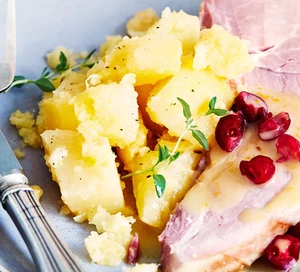
Ingredients
2 large swede , cut into 3cm chunks
1 tsp ground mace
100g butter
2 tbsp clear honey
Method
Put a pan of salted water on to boil. Add the swede and simmer for 20-25 mins until tender. Drain the swede, tip back into the pan and add the mace, butter and honey. Season and crush everything together gently with a potato masher.
from: BBC Good Food